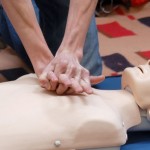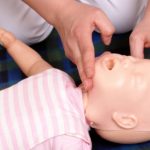Introduction
Cardiopulmonary Resuscitation (CPR) is a crucial medical procedure that can save lives. In performing CPR, rescuers play an essential role in helping a person who is in cardiac arrest. However, sometimes, even with the most skilled and coordinated team, performing CPR can be a challenge. One technique that rescuers can use to enhance the effectiveness of CPR is switching positions. In this article, we will discuss the reasons for and benefits of switching positions, when to switch, the best positions for CPR, how to switch positions, risks and benefits, personal factors that may affect switching positions during CPR and alternative techniques.
Understanding CPR
The Basics of Cardiopulmonary Resuscitation (CPR)

CPR is a lifesaving procedure that is performed when a person’s heart has stopped beating or is in cardiac arrest. The goal is to provide oxygen-rich blood to the brain and other vital organs while waiting for advanced medical care. The procedure involves a combination of chest compressions, ventilation, and other life-saving techniques.
The Steps Involved in Performing CPR
There are six critical steps in performing CPR. These include checking for responsiveness, calling for help, checking the airway, delivering rescue breaths, performing chest compressions, and using an automated external defibrillator (AED).
The Importance of Switching Positions During CPR
Switching positions during CPR can enhance the effectiveness of the procedure. It can provide a different angle of force delivery, prevent rescuer fatigue, and provide an opportunity for the lead rescuer to reassess and give feedback to the team.

The Reasons Behind the Need to Switch Positions
Switching positions can help avoid compression fatigue, which can occur after performing prolonged chest compressions. When fatigue sets in, rescuers may not be able to deliver effective compressions, which can adversely impact the survival of the patient.
How Switching Positions Can Enhance CPR Effectiveness
Switching positions can help provide a different angle of force delivery, ensuring that the compressions reach deeper and more effectively. It can also help avoid rescuer fatigue and ensure that effective compressions are delivered throughout the procedure.
How Switching Positions Can Enhance CPR Effectiveness
Switching positions can help provide a different angle of force delivery, ensuring that the compressions reach deeper and more effectively. It can also help avoid rescuer fatigue and ensure that effective compressions are delivered throughout the procedure.
When to Switch Positions During CPR
Understanding the Conditions that Necessitate a Change in Position
There are times when a switch in position is required. These include compression fatigue, changes in the patient’s condition, the need to rescue and reposition an airway, or feedback from team members.
Signs that Indicate the Need to Switch Positions

Rescue teams should look for signs of fatigue, hesitation, or frustration in the rescuer performing chest compressions. These can indicate that a switch in position is necessary.
Best Positions for CPR
Factors to Consider When Choosing the Right Position for CPR
To choose the best position for CPR, rescuers should consider factors such as the patient’s body type, the rescuers’ strength, and the patient’s medical condition.
Recommended Positions and Techniques for CPR
The most effective method of delivering chest compressions is “two-thumb” or “two-finger” chest compressions. Several recommended positions aim to provide the necessary angle for the best compressions. These include the lateral tilt position, the prone position, the supine position, and the kneeling position.

Common Mistakes to Avoid When Switching Positions
Some common mistakes when switching positions include hesitating, failing to communicate with team members, and insufficient force delivery.
How to Switch Positions During CPR
The Right Techniques to Use When Switching CPR Positions
To switch positions successfully, rescuers should have a plan, communicate effectively, and work as a team. The rescuer who has been performing chest compressions should alert the team of the need for a switch. The team should then smoothly move the patient into the appropriate position.
Training and Certification Requirements for Switching Positions
Switching positions is not always necessary, but it is an important skill that rescuers should learn during CPR training. It is essential to ensure that every member of the rescue team knows when to switch positions, how to do it and to practice it regularly.
The Importance of Teamwork and Communication When Switching Positions
Effective communication and teamwork are critical to successful CPR performance. It is essential to have clear lines of communication and to work as a team to switch positions smoothly and effectively.
The Risks and Benefits of Switching Positions During CPR
The Potential Risks Involved in Switching Positions
Switching positions during CPR can be risky if not done correctly. It can cause delays or errors in compressions, especially if the team has to stop for too long to change positions.
How to Minimize the Risks of Switching Positions
To minimize the risks, rescuers should ensure that the switch is necessary, know when to switch positions, and practice it regularly. The team should work together and communicate effectively to ensure a smooth transition.
The Potential Benefits of Switching Positions
Switching positions can help provide an opportunity for the lead rescuer to reassess and give feedback to the team. It can also prevent fatigue, allowing for more effective compressions throughout the procedure.
Factors to Consider When Deciding to Switch Positions
When the Benefits Outweigh the Risks
Rescuers should switch positions when it is necessary and when the benefits outweigh the risks. It is essential to assess the situation correctly and make informed decisions.

How Rescuers Can Work Together to Make the Best Decision
It is crucial for the team to communicate effectively and work together to make the best decision. Good teamwork and coordinated effort are critical to effective CPR performance, including when to switch positions.
How to Assess the Situation Accurately for a Safe Transition
It is essential to assess the patient’s condition accurately and avoid any unnecessary delays when switching positions. The team should also be aware of the specific circumstances when to switch positions.
Alternative Techniques to Use Instead of Switching Positions
When Switching Positions May Not Be Feasible
In some cases, switching positions may not be feasible. In such cases, alternative techniques can enhance the effectiveness of CPR. These include using mechanical chest compression devices or performing interposed abdominal compressions.
Alternative Techniques to Enhance the Effectiveness of CPR
Other alternative techniques include increasing the ventilation rate, optimizing the chest compression rate, and using extracorporeal life support.
The Role of Technology and Innovation in CPR
New technologies and innovations are continuously being developed to enhance the effectiveness of CPR. For example, smart devices and automated systems can assist rescuers in providing high-quality CPR.
When Switching Positions Doesn’t Work
Other Actions to Take When Switching Positions Does Not Work
If changing positions is not effective, rescuers should re-evaluate and decide on alternative techniques. They should also consider involving advanced medical care.
Knowing When to Involve Advanced Medical Care
Sometimes, despite the best efforts of the team, CPR may not be effective. In such cases, it is essential to involve advanced medical care as quickly as possible to increase the patient’s chances of survival.
Overcoming Personal Doubts and Fears When Switching Positions Doesn’t Work
It is normal to experience stress, doubts, and fear while performing CPR. However, with the right training, experience, and support, rescuers can overcome these challenges and remain focused on delivering high-quality care.
The Importance of Training, Communication, and Planning
Preparing for CPR Emergencies in Advance
Proper preparation for CPR emergencies involves training, certification, practice and planning. The rescue team should be ready to act quickly and provide high-quality care to the patient.
The Role of Training and Certification in Effective CPR Performance
Training, certification, and continuing education are essential to effective CPR performance. Rescuers should be well prepared and equipped to provide high-quality care.
Communication Strategies for Effective CPR Performance
Effective communication is critical to successful CPR performance. The rescue team should have clear lines of communication and work together to provide high-quality care.
Personal Factors that May Affect Switching Positions During CPR
Coping with High Stress Levels During an Emergency Situation
Performing CPR can be highly stressful and challenging. Rescuers should be trained and equipped with techniques to manage stress, stay motivated and focused.
Personal Limitations and How They Impact on Switching CPR Positions
To perform effective CPR, rescuers should be aware of their limits and abilities. It is essential to know one’s limitations and to work with them to ensure effective performance.
Understanding and Managing Individual Mental and Physical Limitations
Effective CPR performance requires a healthy mind and body. Rescuers should take care of their physical and mental health, and seek help when necessary.
Common Questions
Who Can Perform CPR?
Any person can perform CPR. However, it is essential to receive training and certification to ensure proper technique and effective performance.
What Do I Do If I’m Alone and Someone Needs Help?
If you are alone and someone needs help, call for help immediately and start CPR. Do not hesitate to perform CPR if you are the only one around.
Is It Possible to Harm Someone During CPR?
There is a potential risk of injury during CPR. However, the benefits of performing CPR outweigh the risks, and the technique is generally safe when done correctly.
Conclusion
Switching positions during CPR is an essential technique that can enhance the effectiveness of the procedure. Rescuers should be aware of the reasons for, and benefits of switching positions, and when to do it. They should also be aware of other alternative techniques in cases where switching positions may not be feasible. Effective CPR performance requires training, certification, good communication, and teamwork. Rescuers must be aware of their personal limitations and know how to manage stress and overcome doubts and fears during CPR emergencies. With the right skills and knowledge, rescuers can save lives and help people in need.



